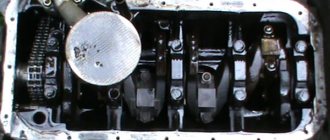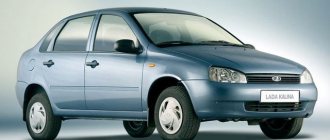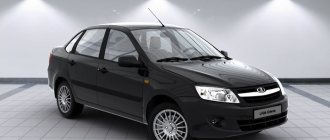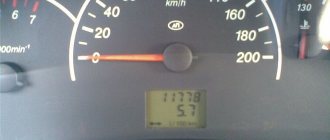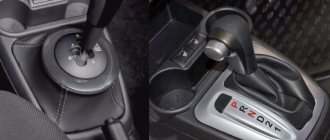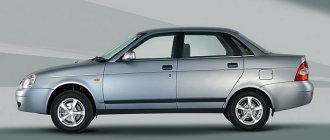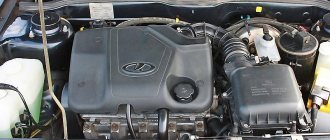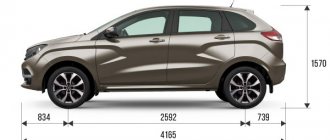Design
VAZ-21053 is the progenitor of the “seven”. Externally, it is very similar to the VAZ-2107, with the exception of the radiator grille. It became the first model in which they strongly decided to abandon chrome (in order to reduce the cost of the design). Thus, the radiator grille was completely black, and the shiny moldings usual for the “Classics” were absent on the body. Other differences include new rectangular headlights with integrated turn signals. Also, other bumpers appeared on the “five”. They were also metal, but more voluminous and lacking “fangs”.
The design of the front side windows has also changed. Previously, the Classic had windows. With the advent of the “five”, the door received solid glass. The design of the rear lights has changed. Otherwise, the body structure remains the same. By the way, initially only 13-inch stamped wheels were offered for the Zhiguli. In the 2000s, 14-inch alloy wheels became available for the VAZ-21053.
Among the disadvantages of this car, owners note the quality of corrosion protection. The car is rotting badly. Therefore, it is not surprising that the “five” could be repainted several times. And touch-ups are completely normal for her. The weak points of the “five” are the sills, bottom and arches. There is no protection against corrosion here. In order to somehow protect against rust, the owners themselves coat the bottom with mastic, treat the thresholds with anti-gravel and other means. Plastic fender liners are also often installed on the car.
Salon VAZ-2105
Initially, the interior of the “five” was conceived as safer, more functional and comfortable compared to its predecessors of the first generation. Safe movement was facilitated by special bars in the door structure, as well as optional hydraulic supports for the front and rear bumpers. All these steps were taken in connection with plans to enter the North American market.
Everyone, good day. I bought myself a Zhiguli 2105 a month ago. I want to share my positivity with everyone. I've been driving for a month, just filling up with gas. I bought it for work, I travel 200-250 km a week, the load is 100-150 kg daily. The appearance is not very good, but the chassis, engine, body (bottom) are just super. Yes, the only thing I did was change the oil. And like a good car, I filled it with Hado oil. I wish everyone that your car brings only pleasant emotions.
Dmitriy
https://www.infocar.ua/reviews/vaz/2105/1981/1.3-mehanika-sedan-id22428.html
The basic equipment included adjustable headrests in the driver and front passenger seats, seat belts in the front seats (in the rear as an additional option). To reduce the effort when rotating the steering wheel, a ball bearing was used in its design.
The instrument panel, door cards, and headliner were made from solid plastic molds. The instrument panel consists of four switches, a block of indicator lamps and three round sections with parameter indicators. To control and monitor the status of various systems, the instrument panel provides:
The interior seat upholstery was originally made of leatherette. Subsequently, most of the interior elements were unified with the VAZ-2107.
Video: review of the VAZ-2105 car
Despite its external simplicity and unpretentiousness, the VAZ-2105 found its admirers not only in the USSR, and subsequently in the countries of the post-Soviet space, but also in countries such as Egypt, New Zealand, and Finland. During the existence of the socialist camp, a large number of these cars were sent to states friendly to the Soviet Union, both for sale on the consumer market and for participation in rally racing. The design of most car mechanisms and components in most cases allows car owners to carry out repairs and maintenance of the vehicle themselves. The interior decoration of the VAZ-2105 can be quite easily reconstructed in order to improve functionality and increase the degree of comfort, so tuning the interior of the “five” is one of the most common ways to independently modify the interior.
Source
Tuning
Recently, the “stens” movement has become increasingly popular. So, the owners tune the VAZ-21053 by installing:
- Classic alloy wheels with a wide shelf.
- Arch extensions.
- JDM style mirrors (placed on the hood).
- “Lips” in the front of the car.
- Spoiler in ducktail style.
The reader can see what the Soviet “five” looks like after this tuning in the photo below.
This car really attracts attention.
VAZ-21053: dimensions, ground clearance
By European standards, the car belongs to the B-class. Thus, the total length of the body is 4.13 meters, width – 1.62, height – 1.45 meters. But it must be said that the length of the wheelbase (2424 millimeters) is very modest even for the B-class. At the same time, the car has impressive ground clearance. On standard 13-inch wheels its size is 17 centimeters. Some owners even raise the rear end. But basically this is not done for cross-country ability (after all, even with standard ground clearance the vehicle could confidently “force” the dirt road), but with the aim of increasing the load capacity. The suspension was very soft and when heavily loaded the rear part sagged a lot.
VAZ-2105
VAZ-2105, description, characteristics, test drive
VAZ-2105 is already a domestic development of the car, which was the result of a deep modernization of the VAZ-2101 car.
The car received a more modern look, which allowed it to successfully sell the car abroad. It must be said that the classic VAZ models were especially popular in Hungary.
The production of the model began in 1979, it was then that small-scale production began.
The car lasted on the Russian assembly line until 2010.
During its production, the body and interior were not modernized. In later models, instead of a 1300 cubic centimeter engine with a power of 69 hp, they began to use a 1450 cubic centimeter engine with a power of 71.4 hp.
Among the classic VAZ models, the “five” was not the most popular car. The reason for this was the engine in the first models, which brought a fly in the ointment; it had a belt driven camshaft. Sometimes the belt would fail and the entire engine would have to be repaired.
There were not many such cases, but word of mouth radio quickly spread this fact, which influenced the demand for the car.
It must be said that the engine was constantly modernized, the main goal of the modernization was to reduce fuel consumption and increase the service life before major repairs.
So in 1985 they began to produce crankshafts with whitened cams.
Carburetors were constantly improved, and the starter also underwent changes.
In 2009, there was a noticeable demand for the VAZ-2105 due to the recycling program; the car was the cheapest of the entire VAZ model range.
However, after the end of the program, the demand for it fell.
In 2010, the VAZ-2105 was discontinued. Moreover, the main reason was not demand, but the need to rebuild capacities to produce a more modern car - the Lada - Grant.
Over the years of production, 2,000,000 VAZ-2105 cars were produced.
Modifications of VAZ 2105:
VAZ-2105 - with a carburetor engine of 1300 cubic centimeters, with a 4-speed. Checkpoint.
VAZ-21050 - with a carburetor engine of 1300 cubic centimeters, with a 5-speed gearbox. Checkpoint.
VAZ-21051 - with a 1200 cubic centimeter carburetor engine, with a 4-speed gearbox.
VAZ-21053 - with a carburetor engine of 1500 cubic centimeters or an injection VAZ-2104 with a 5-speed. Checkpoint.
VAZ-21054 is a small-scale modification for traffic police, the Ministry of Internal Affairs and the KGB with an additional gas tank and battery.
VAZ-21055 - with a diesel engine of 1500 cubic centimeters Barnaultransmash, small-scale modification for taxis.
VAZ-21057 (Lada Riva) - an export version of the VAZ-21053 with right-hand drive, produced in 1992-1997 for deliveries to the UK.
VAZ-21058 is an export version of the VAZ-21050 with right-hand drive, produced in 1982-1994 for the UK.
VAZ-21059 - with a rotary engine 1300 cubic centimeters VAZ-4132 with a power of 140 hp, used in the traffic police.
Technical characteristics of the VAZ-2105:
| 2105 | 21051 | 21053 | 21055 | 21059 | |
| Execution: | Four-stroke, gasoline, carburetor, four-cylinder | diesel | rotary | ||
| Body type | sedan | ||||
| Number of doors | 4 | ||||
| Places | 5 | ||||
| trunk volume, dm 3 | 345 | ||||
| Overall dimensions, mm: | |||||
| length | 4130 | ||||
| width | 1620 | ||||
| height | 1446 | ||||
| own weight, kg | 995 | ||||
| payload, kg | 400 | ||||
| Wheelbase, mm | 2424 | ||||
| Front wheel track | 1365 | ||||
| Rear wheel track | 1321 | ||||
| Drive wheels | rear | ||||
| Ground clearance to floor pan | 182 | 182 | 182 | ||
| Clearance to rear axle beam | 170 | ||||
| Clearance to front suspension beam | 175 | ||||
| Engine | 2105 | 2101 | 2103 | 341- diesel | VAZ 4132 |
| working volume, cubic meter cm | 1290 | 1198 | 1452 | 1524 | 1308 |
| Max. power, kW (at rpm) | 46,8 (5600) | 43,2 (5600) | 37(4600) | 103 (6000) | |
| Max. power, l. With . | 63,6 | 58,7 | 71,1 | 50,3 | 140 |
| Max. torque mine ., Nm (at rpm) | 92(3400) | 85 (3400) | 103,9(3400) | 92,0 (2500) | 186 (4500) |
| supply system | carburetor | carburetor | carburetor | ||
| KP | |||||
| Number of gear stages | 5 or 4 | 4 | 5 or 4 | 5 | 5 |
| Gearbox ratios: | |||||
| I | 3,67 | 3,67 | 3,67 | 3,636 | 3,636 |
| II | 2,1 | 2,1 | 2,1 | 1,95 | 1,95 |
| III | 1,36 | 1,36 | 1,36 | 1,357 | 1,357 |
| IV | 1 | 1 | 1 | 0,941 | 0,941 |
| V | 0,82 | 0,82 | 0,784 | 0,784 | |
| reverse | 3,53 | ||||
| Final drive ratio | 4,1 | 4,3 | 4.1 or 3.9 | 3,9 | 3,9 |
| Maximum speed, km/h | 145 | 142 | 150 | 125 | 180 |
| acceleration to 100 km/h, s | 18 | 20 | 17 | 23 | 9 |
| Fuel consumption, l/100 km: | |||||
| fuel consumption at 90 km/h | 7,5 | 5,8 | 9,5 | ||
| fuel consumption at 120 km/h | 10,1 | 8,0 | 12,5 | ||
| fuel consumption in the urban cycle | 10 | 6,7 | |||
| Fuel tank capacity, l | 39 | ||||
| Front brakes | disk | ||||
| Rear brakes | drums | ||||
| Braking distance loaded from 80 km/h | 38 | ||||
| Parking brake drive | cable | ||||
| Clutch drive | hydraulic | ||||
| Front suspension | independent | ||||
| Rear suspension | five-rod | ||||
| Steering | worm - roller | ||||
| Smallest turning radius | 5,6 | ||||
| The weight of the towed trailer is storm. | 600 | ||||
| Towed trailer weight without brakes | 300 | ||||
| Max, roof rack weight | 50 | ||||
| Maximum lift without acceleration | 34 | 34 | |||
| Resource until the first cap. repair, km | 150 000 | ||||
| Cold start temperature, C | -25 | ||||
| Tires | 13″ | 13″ | 13″ | 165/70R13 175/70R13 | 13″ |
| Dashboard | 2105 | ||||
| Seats | 2105 | ||||
| Rear window defroster | + | + | + | + | + |
| Cooling fan | mechanical | mechanical | mechanical | ||
| Bumpers | aluminum | ||||
| Exterior mirrors | left | ||||
| Seat upholstery | is . leather | ||||
| Headlining | film | ||||
| Door trim | unified | ||||
VAZ-2105: test drive
- 80
20 179
Author: total-rating.ru
Salon
Inside, the car looks the same as the “four” and “seven”. The driver has a four-spoke steering wheel without any adjustment and a flat fabric seat. The instrument panel on the VAZ-21053 is a pointer panel with modest backlighting. Nevertheless, everything necessary was located here: speedometer, tachometer, fuel level and antifreeze temperature sensor.
By the way, the “five” became the first car among the “Classics”, which was standardly equipped with a heated rear window. In addition, the front door windows have been ventilated in the cabin. However, in order to place deflectors in the panel, it was necessary to reduce the already small-sized glove compartment. The interior here is so simple that the only electronic items are interior lighting and rear window heating. All window regulators are mechanical. The seats are manually adjustable. Among the shortcomings in the interior, the owners note:
- Poor sound insulation. It is very noisy inside, especially at speed, when the roar of the engine can be heard from under the hood.
- Uncomfortable seats. Although they received height-adjustable headrests, they were extremely uncomfortable. There was no lumbar and lateral support. In addition, the seats quickly sank and rubbed. Because of this, you could often see covers on the seats of Zhiguli cars.
- Bad ergonomics. In particular, this concerned the steering wheel and inconvenient controls on the stove.
Review of the Lada 2105 model
The VAZ-2105 car was produced at the Tolyatti Automobile Plant (as well as at the KraSZ factories in Ukraine and Lada Egypt in Egypt) for 31 years - from 1979 to 2010, i.e. it was in production longer than any other VAZ model. By the end of the 2000s, thanks to the minimum configuration, the “five” was cheaper than each of the Volzhsky Automobile Plant models produced at that time - 178 thousand rubles in 2009.
The VAZ-2105 car was produced at the Tolyatti Automobile Plant from 1979 to 2010
Having replaced the first-generation Zhiguli, the VAZ-2105 received a more contemporary appearance at that time with angular shapes and matte black decorative elements instead of the previously used chrome ones. The creators of the new model sought not only to simplify assembly, but also to achieve an acceptable cost for the car . For example, the abandonment of chrome-plated parts made it possible to get rid of the long and labor-intensive technological process of applying several layers of non-ferrous metals to steel. Among the innovations that were not present on previous VAZ models were:
- timing belt (instead of the previously used chain);
- polyurethane panels in the interior, made by solid stamping;
- block headlights equipped with hydraulic corrector;
- combination of clearance lights, turn signals, reversing lights, brake lights and fog lights under one rear lamp shade;
- heated rear window as standard.
In addition, the rotating wind triangles on the windows of the front doors of the new car were removed, and side nozzles began to be used to blow these windows. The driver could now adjust the position of the side mirrors from the passenger compartment; height-adjustable headrests were provided for front passengers.
A very good car for the money, I bought it as my first car and didn’t regret it later. I drove it for 1.5 years, invested a little after the previous owner and hit the road! During operation, no special problems arose, just little things related to maintenance, you just need to change everything on time and take care of the car, and not wait until it falls off on its own! Possibility of tuning, a large selection of spare parts, and all auto stores have almost all spare parts, not counting disassembly ones.
The rotating wind triangles on the windows of the front doors of the new car were removed, and side nozzles began to be used to blow these windows
The VAZ-2105 body number can be found under the hood near the windshield closer to the passenger seat . The vehicle's registration data is indicated on a special plate located on the bottom shelf of the air supply box. In addition, the vehicle identification code indicated in the table is duplicated in the luggage compartment. To see it, you need to use a Phillips screwdriver to unscrew the screw holding the rear wheel arch trim and remove the trim.
The vehicle's passport data is indicated on a special plate located on the bottom shelf of the air supply box; next to the plate (1 with a red arrow) VIN is stamped (2 with a red arrow)
The summary plate shows:
- 1 - number used for selecting spare parts;
- 2 - manufacturer;
- 3 — conformity mark and vehicle type approval number;
- 4 — VIN of the car;
- 5 — engine brand;
- 6 — maximum load on the front axle;
- 7 — maximum force on the rear axle;
- 8 — marking of version and configuration;
- 9 - maximum permissible weight of the machine;
- 10 is the maximum permissible weight of the vehicle with trailer.
Video: introduction to the first version of the VAZ-2105 model
This is interesting: Which oil is 5w30 or 5w40
Chassis of the “five”
It is almost similar to other classic VAZ models. Thus, an independent spring suspension with transverse swing arms was installed on the front of the car. There is also a stabilizer bar at the front. At the rear there is a spring dependent suspension with longitudinal and transverse bars. The brake system is hydraulic, dual-circuit, with a vacuum booster. Disc brakes are installed at the front, drum brakes at the rear. The handbrake is mechanical, with drive to the rear wheels.
As reviews note, the suspension on the “five” is very soft. It is able to dampen vibrations even at high speeds. But at the same time, the suspension did not tolerate sharp impacts. Due to breakdowns, owners were faced with deformation of the axles of the lower arms. Also, due to the excessively soft suspension, the car took turns poorly and was practically uncontrollable at high speeds. Reviews include all hinge joints as weak points in the chassis. These are steering rods and ball joints. The shock absorbers quickly became unusable due to the large suspension travel. Also, due to low-grade metal, wheel bearings have to be replaced frequently.
At the moment, the VAZ-21053 can be purchased at an average price of 15 to 60 thousand rubles. The condition of the cars will vary, as will the mileage. But the most expensive are the “fresh” copies released in 2010. The price can reach up to 120 thousand rubles.
Vehicle Specifications
| Indicators | VAZ-2105 | VAZ-21051 | VAZ-21053 | VAZ-2104 | VAZ-21043 |
| Total information | |||||
| Number of seats | 5 | 5 | 5 | 5 | 5 |
| Useful weight, kg | 400 | 400 | 400 | 455 | 455 |
| Gross vehicle weight, kg | 1395 | 1395 | 1395 | 1475 | 1475 |
| dimensions | see fig. | see fig. | |||
| Maximum speed, km/h: | |||||
| with driver and passenger | 145 | 142 | 150 | 135 | 143 |
| Acceleration time from standstill with gear shifting to a speed of 100 km/h, s: | |||||
| 18 | 20 | 17 | 18,5 | 17 |
| Outer smallest turning radius along the front wheel track axis, m | 5,6 | 5,6 | 5,6 | 5,6 | 5,6 |
| Braking distance of a vehicle with full weight at a speed of 80 km/h, no more | 43,2 | 43,2 | 43,2 | 43,2 | 43,2 |
| Engine | |||||
| Model | 2105 | 2101 | 2103 | 2105 | 2103 |
| Type | four-stroke, gasoline, carburetor, four-cylinder | ||||
| Cylinder diameter and piston stroke, mm | 79×66 | 76×66 | 76×80 | 79×66 | 76×80 |
| Working volume, l | 1,294 | 1,198 | 1,452 | 1,294 | 1,452 |
| Compression ratio | 8,5 | 8,5 | 8,5 | 8,5 | 8,5 |
| Rated power at crankshaft speed 5600 rpm 1 kW (hp): | |||||
| 46,8 | 43,2 | 51,6 | 46,8 | 51,6 |
| (63,6) | (58,7) | (70,2) | (63,6) | (70,2) | |
| 47,8 | 44,2 | 52,6 | 47,8 | 52,6 |
| (65) | (60) | (71,6) | (65) | (71,6) | |
| Maximum torque at crankshaft speed 3400 min" 1, N.m (kgcm): | |||||
| 92 | 85 | 103,9 | 92 | 103,9 |
| (9,38) | (8,67) | (10,58) | (9,38) | (10,58) | |
| 94,02 | 86,87 | 106,08 | 94,02 | 106,08 |
| (9,58) | (8,85) | (10,81) | (9,58) | (10,81) | |
| Cylinder operating order | 1-3-4- 2 | ||||
| Transmission | |||||
| Clutch | single-disc, dry with central pressure spring | ||||
| Transmission | mechanical, three-way, four- or five-speed with synchronizers in all forward gears | ||||
| Gear Ratios: (4-speed transmission has the same ratios, but without fifth gear) | |||||
| 3,67 | 3,67 | 3,67 | 3,67 | 3,67 |
| 2,10 | 2,10 | 2,10 | 2,10 | 2,10 |
| 1,36 | 1,36 | 1,36 | 1,36 | 1,36 |
| 1,00 | 1,00 | 1,00 | 1,00 | |
| 0,82 | — | 0,82 | 0,82 | 0,82 |
| 3,53 | 3,53 | 3,53 | 3,53 | 3,53 |
| Cardan transmission | two shafts with an intermediate elastic support, connected to the gearbox shaft with an elastic coupling. The two rigid universal joints at the ends of the rear shaft have needle bearings | ||||
| main gear | conical, hypoid | ||||
| 4,1 | 4,3 | 4.1 or 3.9 | 4,1 | 4.1 or 3.9 |
| Chassis | |||||
| Front suspension | Independent, wishbone, with coil springs, telescopic hydraulic shock absorbers and anti-roll bar | ||||
| Rear suspension | dependent, rigid beam connected by a bodywork with one transverse and four longitudinal rods, with coil springs and hydraulic shock absorbers | ||||
| Wheels | stamped disk | ||||
| 127J—330 (5J—13) | ||||
| Tires | chamber radial 175/70 R13 or 165/8OR13 (165SR13). | ||||
| Steering | |||||
| Steering | safety, with intermediate cardan shaft | ||||
| Steering gearbox | with globoidal worm and double-ridge roller on ball bearings, gear ratio 16.4 | ||||
| Steering gear | three-link, consists of one middle and two lateral symmetrical rods, bipod, pendulum and swing arms | ||||
| Brakes | |||||
| Service brakes | |||||
| disc with two opposing hydraulic cylinders and automatic restoration of the specified gap | ||||
| drum, with self-centering shoes and automatic restoration of the gap between the shoes and the drum, with a pressure regulator | ||||
| Service brake drive | foot, hydraulic, dual-circuit, with vacuum booster | ||||
| Parking brake | manual with cable drive on rear brake pads | ||||
| Electrical equipment | |||||
| Electrical wiring system | single-wire, the negative pole of the current sources is connected to ground. Nominal voltage 12 V | ||||
| Accumulator battery | 6ST55P, capacity 55 Ah at 20-hour mode | ||||
| Generator | G222, AC with built-in rectifier and voltage regulator. Output current 45 A at 5000 rpm* 1 | ||||
| Starter | ST221 with electromagnetic traction relay and freewheel, power 1.3 kW | ||||
| Spark plug | A17DV or FE65P with M14x1.25 thread | ||||
| Body | |||||
| Model | VAZ-2105 | VAZ-2104 | |||
| Type | sedan, all-metal, monocoque, four-door | station wagon, solid metal, load-bearing | |||
Inexpensive AvtoVAZ model
In 2008-2009, the car was considered the cheapest on the Russian market. For reasons of market conditions, prices were steadily declining, since the demand for the car was insignificant. Its popularity was not helped by its ascetic equipment and lack of accessories that make the car a comfortable means of transportation. In addition, during that period the VAZ-2107 model appeared - a direct competitor to the “five”. Since the unification was almost one hundred percent, it was decided to produce only one of them - the VAZ-2107.
VAZ-21053 – technical characteristics
- Production - Russia, Volzhsky Automobile Plant in Tolyatti.
- Layout - rear-wheel drive, front-engine.
- Platform – VAZ-2101.
- Number of seats – five-seater.
- The steering wheel position is left-hand.
- Issue – from 1980 to 2009.
- Construction – all-metal, welded.
- Type – sedan, four-door. Reverse lift hood. The trunk lid is hinged, without pneumatics.
- Cylinder displacement – 1452 cc/cm.
- Number of cylinders – 4, in-line arrangement.
- The diameter of the pistons is 79 mm.
- The piston stroke is 80 mm.
- Piston rings are gray cast iron, upper oil scraper ring is chrome plated.
- Power – 71 l. With. at 5600 rpm.
- Torque – 103/3400 Nm/rpm.
- The fuel mixture supply system is injection, with distributed injection (on the VAZ-21053 the injector was installed selectively, mainly on cars produced in small series).
- Timing gear – overhead camshaft, nitrided hardened cams, bleached.
- The number of valves per cylinder is 2.
- Lubrication is forced under pressure.
- Fuel - A-93 gasoline, leaded.
The gearbox is a four-speed manual.
- 3.75 – first gear;
- 2.30 – second gear;
- 1.49 – third gear;
- 1.00 – fourth (direct) gear;
- 3.87 – reverse gear;
- forward gears – helical profile, constant meshing;
- reverse gears are straight.
Technical characteristics of VAZ-21053
This modification could be equipped with several engines. Initially, the VAZ-21053 was equipped with a carburetor engine from the Troika. It was an eight-valve one and a half liter engine with a timing chain and a power of 72 horsepower. Torque – 104 Nm. The gearbox could be different. At first, the “five” was equipped with a four-speed manual, and then with a five-speed one.
In 2000, the carburetor engine was replaced with an injection engine. So, under the hood of the “classic” there was a “four” engine with distributed injection. With a volume of 1.5 liters, it developed the same 72 horsepower. However, the torque has increased. Now it is 110 Nm. Also, the power unit began to comply with the Euro-2 environmental standard. There was no alternative mechanics offered as a transmission. As experience in operating the VAZ-21053 shows, the box began to howl over time due to the bearings. But this was not considered a serious disadvantage.
Among the main disadvantages of the Zhiguli, the owners noted poor acceleration dynamics. Depending on the type of engine and gearbox, the “five” accelerated to hundreds in 17-20 seconds. The maximum speed ranged from 142 to 150 kilometers per hour. At the same time, the car was voracious. The classic engine consumed an average of 10 liters of 92-grade gasoline per 100 kilometers. Moreover, on the highway this consumption did not drop significantly, due to the “brick” aerodynamics.
The engine had the same shortcomings as other Zhiguli engines. These are rapid wear of the camshaft, the need to adjust the valves, increased oil consumption, problems with the ignition system, etc. With proper maintenance, the engine life before major overhaul was about 180 thousand kilometers.
Chassis
The basic basis for the VAZ-21053 model was the 2101 platform. There were no design changes, except for rearranging the brackets when releasing export modifications with right-hand drive.
The front suspension of the VAZ-21053 is two independent units (left and right), consisting of profiled stamped arms that are attached to the transverse beam using silent blocks. The ends of the levers are connected to the steering axle by means of ball joints. Each pair of levers rests on a steel spiral spring, which, with its upper ring, fits into a special socket mounted in the sides of the engine compartment. A hydraulic shock absorber is installed in the middle of the spiral. Both lever units are connected to each other by a rod, which dampens vibrations and ensures lateral stability of the car.
The rear suspension of the pendulum design consists of trailing arms connecting the underbody to the axle beam. Spring coils along with shock absorbers are also an integral part. The lateral stability of the car is ensured by a special stabilizer beam located behind the rear axle.
Installing a Solex 21053 carburetor on a classic
Solex device
Now we can begin the process of replacing the original carburetor of the car with Solex modification 21053 1107010 20. On VAZs, the old carburetor is usually Ozone, produced on the basis of DAAZ. Its main problem is that it is not nearly as reliable as we would like. In addition, its fuel consumption is slightly higher than that of the Solex. That is why one is replaced by another. In addition, in order to simply install Solex 21053 on a classic, it is advisable to configure it correctly.
The procedure for installing the Solex 21053 carburetor on a classic is no different from installing other models of this device on it. Solex 21053 for classics can easily be placed in any rear-wheel drive VAZ engine. So, first you need to eliminate any possibility of foreign particles getting into the intake manifold. We achieve this goal by cleaning the engine compartment from dirt. There is no need to achieve perfect shine. Just wash it.
Now disconnect the ozone carburetor from whatever is holding it in the car. Be careful when disconnecting the hoses from the heating system and fuel hoses. Having done this, you need to remove the cable from the air damper. It is attached to a bracket, which must be removed first. Then you can take out the old carburetor. For the same purpose for which you washed the engine compartment, you should also clean the area where Ozone stood. If during the process you find any cracks, holes or irregularities on the surface, you must cover them with sealant.
Now it’s time to create thermal insulation for Solex 21053 1107010 20. Insulating gaskets will help achieve this. They should be stacked on top of each other, alternating thin and denser ones. Install carburetor 21053 1107010 20 on top. For greater comfort in the future, you should install Solex 21053 on the classic without the top cover. In this case, the throttle valve drive should not be located behind. On the side of the upper part of the cylinder head, you need to place the drive linkage from the primary and secondary chambers. The task of the rocker is to regulate the throttle valve. On the old Ozone you will find simple plastic traction tips; you can remove them and install them instead of the tips on the Solex.
Now you need to adjust the length of the cable from the throttle valve drive. If it turns out to be slightly longer than the distance to the carburetor, it needs to be trimmed. Having made these changes, you can close the cover on the carburetor. The old gasket should not be used. Having closed the carburetor with a lid, you should begin connecting it to everything that you disconnected from Ozone. Connect the carburetor tee to the cooling system. Now you need to extend the hoses from the ignition system distributor. Then install a tee at the fine filter. It should be placed on the fuel line. Connect the wire leading to the carburetor float chamber to the tee. This must be done using a check valve. Now all that remains is to attach the return spring back, and for the first time (for safety) you can also install an additional one, attaching it to the top of the block.
Connect the electric valve to the light relay, and then install the air filter base and filter element and connect them to the gas exhaust system. A Solex 21053 carburetor is installed on the classic. 21053 1107010 20 will last a long time if you follow some rules for setting it up and cleaning it from time to time.
Brake system
The VAZ-21053 model was equipped with efficient dual-circuit hydraulics. From the central brake cylinder, pressure was supplied to the front and rear wheels according to a separate scheme. One pipeline connected the cylinder to the left front and right rear wheels, and the other connected the left rear wheel to the right front. This separation provided braking in case of failure of one of the circuits.
The front brakes, non-ventilated disc pads, were driven by a caliper covering the brake disc on both sides. The pistons were equipped with special rubber sealing rings that returned them to their original position after each press on the brake pedal.
The rear brakes, drum type, consisted of two self-adjusting shoes, driven by a hydraulic cylinder. The pads returned to their original position under the action of a spring. The design also included a handbrake mechanism controlled from the interior. The handbrake lever was located in the cabin, between the front seats.
Subcompact car VAZ-21053, photo and description
Since 1999, a collapse in prices began on the Russian automobile market, caused by the 1998 default. The VAZ-21053 model, whose engine left much to be desired in terms of gas distribution parameters and some other characteristics, also suffered from unstable market conditions. Stores selling cars, one after another, refused deliveries. Demand for the VAZ-21053 car, the technical specifications of which have not been updated for years, was moderate, starting in 2000 until the closure of production in 2009. After the Oka minicar was discontinued in November 2008, the Lada-2105 and all its modifications became the cheapest cars on the Russian market.
Specifications
In 1983, the VAZ-2105 was awarded the USSR quality mark, which confirmed the correctness of the path taken by the creators of the model: the car had a fairly presentable appearance and quite acceptable technical characteristics.
Table: technical characteristics of VAZ-2105
Vehicle weight and dimensions
The dimensions of the VAZ-2105 make it possible to operate the car quite comfortably in urban conditions . The turning circle of the “five” is 9.9 m (for comparison, for the VAZ-21093 and VAZ-2108 this figure is 11.2 m). The dimensions of the VAZ-2105 are:
- length, i.e. the distance from the farthest point of the front bumper to the outermost point of the rear bumper - 4130 mm;
- the width, which is measured, as a rule, between the extreme points of the wheel arches or the central pillars of the body, is 1620 mm;
- height - distance from ground to roof - 1446 mm.
The curb weight of the car is 995 kg, the trunk holds up to 385 liters, and the ground clearance is 170 mm.
The trunk of the VAZ-2105 has a volume of 385 liters
Engine
The VAZ-2105 power unit was designed based on the engine installed on the Ford Pinto. That is why the “five” received a belt drive for the gas distribution mechanism instead of a chain, due to which the predecessors of the VAZ-2105 were characterized by an increased noise level. It is known that the use of a timing belt helps ensure that the engine does not bend the valves: if the force inside the system exceeds the permissible value, the belt drive breaks, preventing deformation of the valves and, as a result, expensive repairs.
I bought a car like this and thought I would drive it for a long time. I bought it for 500 bucks, immediately sent the body for cooking/painting, and overhauled the engine myself. It all took about 600 USD. That is, but for this money I replaced absolutely everything, down to the smallest detail. The engine is belt driven, really playful, and picks up speed instantly. The ride is interesting but there is very little traction. The 4-speed gearbox offers excellent gear selection, but the lever is located inconveniently. With my height of 190 cm, it is difficult to get behind the wheel, because it rests dully on my knees. I overhauled the steering column and managed to lift it slightly. Still uncomfortable. I threw out the seats without headrests, bought them from 2107. The landing is idiotic, I drove for a month, changed them to Mazda ones. The seat is comfortable, but now very high. Door locks are terrible. There is no point in talking about handling - moving quickly is only possible along a straight path, the car rolls heavily.
The engine of the VAZ-2105 car has a power of 64 hp. With. and volume 1.3 liters
The original carburetor version of the engine provided a power of 64 hp. With. with a volume of 1.3 liters. Subsequently, when an injection version of the engine appeared, the power increased to 70 hp. With. At the same time, the injection engine is more demanding on fuel quality and runs on gasoline with an octane rating of at least 93. The engine body was made of cast iron, resistant to high temperatures, so failure of the power unit due to overheating was very rare. The motor was distinguished by its simplicity of design, which allowed the car owner to independently carry out most of the activities related to the maintenance of the unit.
Thanks to the short piston stroke, which is 66 mm for the “five” (for the VAZ-2106 and VAZ-2103 this figure is 80 mm), as well as the cylinder diameter increased to 79 mm, the engine turned out to be quite revvy, continuing to maintain a high torque value at rpm 4000 rpm and above. Previously produced models did not always cope with this task and worked more reliably at low and medium speeds.
The four cylinders of the engine are in-line, each cylinder has 2 valves, and the torque is 3400 N*m. The use of an aluminum valve cover contributed to reducing the noise level during engine operation. Subsequently, this engine model was successfully used on the VAZ-2104.
Since 1994, VAZ-21011 or VAZ-2103 engines have been installed on VAZ-2105 cars . In addition, various modifications of the VAZ-2105 were equipped with engines at different times:
- VAZ-2105 with a 5-speed gearbox;
- VAZ-2104 with distributed injection and 5-speed gearbox;
- VAZ-2106 (small series for the State Traffic Safety Inspectorate, Ministry of Internal Affairs, FSB);
- VAZ-21067 with distributed injection and 5-speed gearbox;
- diesel VAZ (BTM)-341 (small series for taxi);
- VAZ-21053 for export Lada Riva and others.
Lada Riva - export version of the VAZ-2105 - was equipped with a VAZ-21053 engine
Refill containers
The VAZ-2105 is equipped with refueling tanks, the volume of which is (in liters):
- fuel tank - 39 (for VAZ-2104 - 42);
- cooling system together with heating system - 8.65;
- lubrication system - 3.75;
- 4-speed gearbox housing - 1.35;
- 5-speed gearbox housing - 1.6;
- hydraulic clutch - 0.18;
- hydraulic brake drive - 0.382;
- rear axle housing - 1.3;
- front shock absorber - 0.11;
- rear shock absorber - 0.18;
- steering gear housing - 0.215;
- windshield washer reservoir - 2.0 (5.0);
- rear window washer reservoir (for VAZ-2104) - 2.0;
- vacuum pump with control hole - 0.15.
The fuel tank of the VAZ-2105 holds 39 liters
Recycling program
The car was not in demand, and the manufacturer had already begun to suffer losses. The situation was smoothed out after the introduction of a recycling program, when the owner of an old car received 50,000 rubles from the state as compensation for melting it down. During this period, all AvtoVAZ models, including the VAZ-21053, again became in demand. Prices rose, and then a balancing act began between the cost of the scrappage certificate and the market value of the car. This continued until the model was removed from the assembly line (2009).
Why did the car attract buyers, albeit few? First of all, the availability of spare parts and components, which were relatively inexpensive. In addition, the attractiveness of the VAZ-21053 for Russians was the possibility of repairing and servicing it on their own (in the garage, on the site, or simply “in the field”). This circumstance somewhat leveled out the low demand for the car, but its prestige on the world market fell hopelessly. The car was no longer equipped with even the most necessary accessories; it got to the point that at the beginning of 2009, the daily mileage counter was removed from the dashboard.
Types of carburetors
It should be said that there are only three types of carburetors on VAZ. These are Weber, Solex and Ozone carburetors. All three are successfully used on domestic cars, since almost all of them were developed for this purpose. The exception is the Weber carburetor. Its history begins in Italy, and since some Russian cars also have these roots, the Italian carburetor feels the best in them. The creator is Eduard Weber, the man who gave the world improved dynamic performance of cars, as well as lower fuel consumption.
The next carburetor is Ozone. The main goal in its development was to reduce fuel consumption. At the moment, Ozone can still be found on many cars, but they are becoming less and less common. The fact is that the carburetor often breaks down. Of course, it cannot be called completely useless, because it fulfilled its task (to create lower fuel consumption compared to Weber) perfectly. And if you configure it correctly, then the dynamic performance will also be quite good.
Weber device
The next carburetor is Solex 21053 1107010. 21053 1107010 20 is a Solex carburetor of the fifth modification. Solex is a French company that has long ceased producing its products. Her business was picked up by DAAZ (Dimitrovsky Avtoaggregatny Zavod), which continues to do so to this day. The difference between Solex and Ozone is minimal, but significant. It lies in the fact that the carburetor does not break. At the same time, its performance is not bad, they can be improved by properly setting up the device. However, the process of setting up the carburetor is not the easiest, and it is for this reason that the Solex 21053 1107010 carburetor is mentioned above. The fact is that the modification 21053 1107010 20 has already been adjusted to the maximum, and you simply need to install it correctly. By the way, you can also slightly adjust the characteristics of the device.
